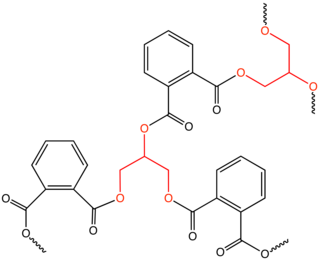Chemistry



In organic chemistry, an ester is formed as the condensation product of a carboxylic acid and an alcohol, with water formed as the condensate by-product. An ester can also be produced with an acyl halide and an alcohol, in which case the condensate by-product is a hydrogen halide.
Polyesters are a category of polymers in which ester functionality repeats within the main chain. Polyesters are a classic example of step-growth polymer, in which a difunctional (or higher order) acid or acyl halide is reacted with a difunctional (or higher order) alcohol. Polyesters are produced commercially both as saturated and unsaturated resins. The most common and highest volume produced polyester is Polyethylene terephthalate (PET), which is an example of a saturated polyester and finds utilization in such applications as fibers for clothing and carpet, food and liquid containers (such as a water/soda bottles), as well as films. [11]
In unsaturated polyester (UPR) chemistry, unsaturation sites are present along the chain, usually by incorporation of maleic anhydride, but maleic acid and fumaric acid are also used. Maleic acid and fumaric acid are isomers where maleic is the cis-isomer and fumaric is the trans-isomer. The ester forms of these two molecules are maleate and fumarate, respectively. When curing a UPR, the fumarate form is known to react more rapidly with the styrene radical, so isomerization catalysts, such as N,N-dimethylacetoacetamide (DMAA), are often employed in the synthesis process which converts the maleates into fumarates; the isomerization can also be encouraged with increased reaction time and temperature. Within the UPR industry, the classification of the resins is generally based on the primary saturated acid. For example, a resin containing primarily terephthalic acid is known as a Tere resin, a resin containing primarily phthalic anhydride is known as an Ortho resin, and a resin containing primarily isophthalic acid is known as an Iso resin. Dicyclopentadiene (DCPD) is also a common UPR raw material, and can be incorporated two different ways. In one process, the DCPD is cracked in situ to form cyclopentadiene which can then be reacted with maleate/fumarate groups along the polymer chain via a Diels-alder reaction. This type of resin is known as a Nadic resin and is referred to as a poor man's Ortho, due to sharing many similar properties of an Ortho resin along with the extremely low cost of DCPD raw material. In another process, maleic anhydride is first opened with water or another alcohol to form maleic acid and is then reacted with DCPD where an alcohol from the maleic acid reacts across one of the double bonds of the DCPD. This product is then used to end-cap the UPR resin which yields a product with unsaturation on the end-groups. This type of resin is referred to as a DCPD resin.
Ortho resins comprise the most common type of UPR, and many are known as general purpose resins. FRP composites utilizing ortho resins are found in such application as boat hulls, bath ware, and bowling ball cores.
Iso resins are generally on the higher end of UPR products, both because of the relatively higher cost of the isophthalic acid as well as the superior properties they possess. Iso resins are the primary type of resin used in gel coat applications, which is similar to a paint, but is sprayed into a mold before the FRP is molded leaving a coating on the part. Gel coat resins must have lower color (almost clear) so as to not impart additional color to the part or so that they can be dyed properly. Gel coats must also have strong resistance to UV-weathering and water blistering.
Tere resins are often used when high modulus and strength are desired, but the low color properties of an Iso resin is not necessary. Terephthalic acid is generally lower cost than isophthalic acid, but both give similar strength characteristics to a UPR product. There exists a special sub-set of Tere resins, known as PET UPR resins, which are produced by catalytically cracking PET resin in the reactor to yield a mixture of terephthalic acid and ethylene glycol. Additional acids and glycols are then added along with maleic anhydride and a new polymer is produced. The end product is functionally the same as a Tere resin, but can often be lower cost to manufacture as scrap PET can be sourced cheaply. If a glycol-modified PET (PET-G) is used, exceptional properties can be imparted to the resin due to some of the exotic materials used in PET-G production. Tere and PET-UPR resins are used in many applications including cured-in-place pipe. [12]















